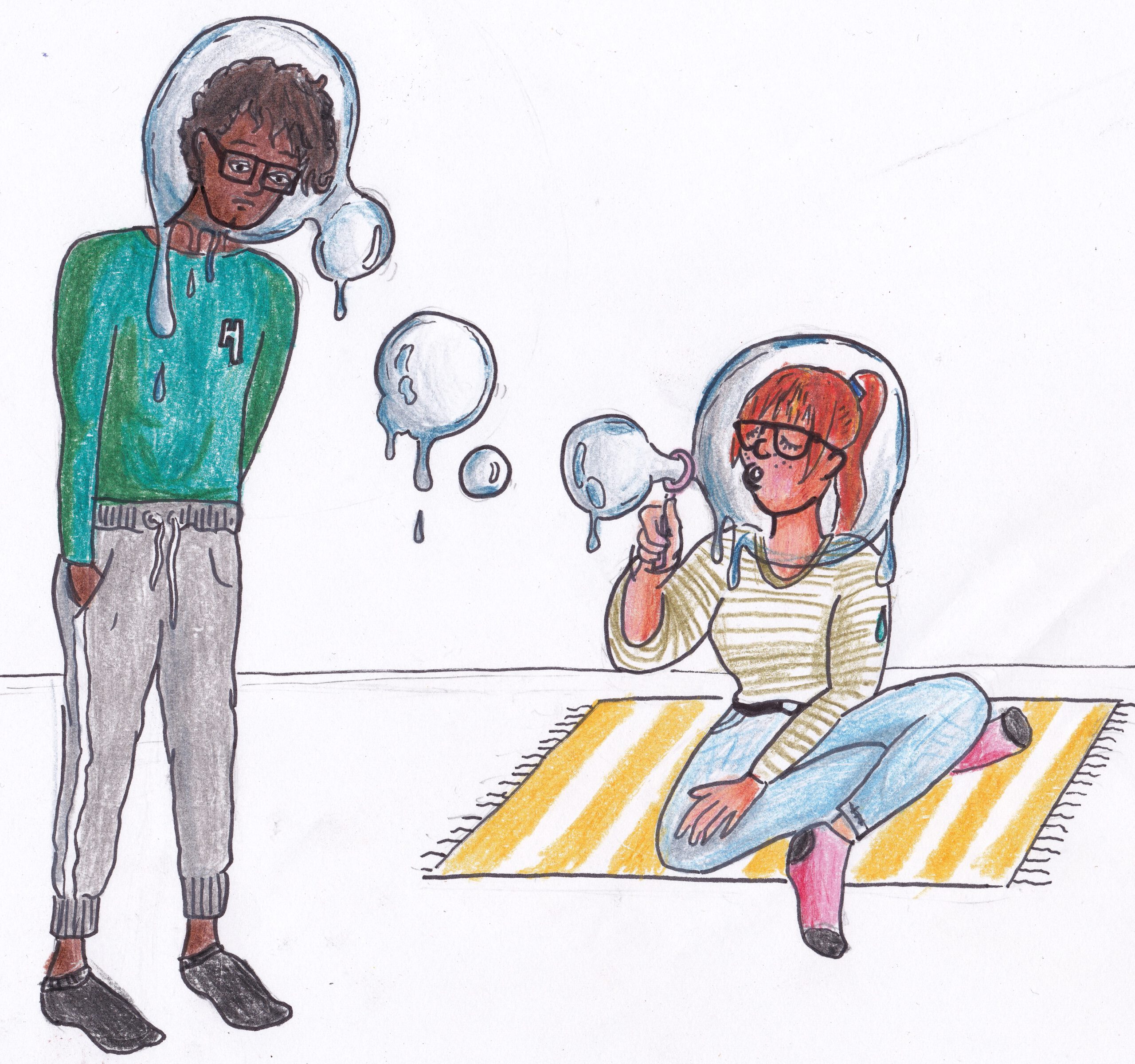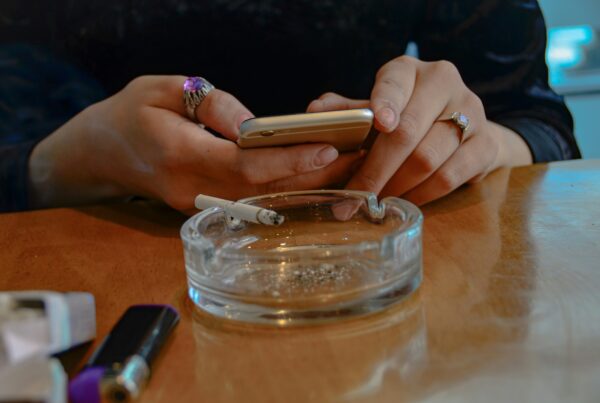
In the past weeks, everyone has been afraid of catching or spreading the coronavirus. Rightfully so, as personal responsibility can save lives in this case. Should our vigilance end with this air-borne disease? Research shows that depression can be contagious as well.
In the past weeks, everyone has been afraid of catching or spreading the coronavirus. Rightfully so, as personal responsibility can save lives in this case. Should our vigilance end with this air-borne disease? Research shows that depression can be contagious as well.

Illustration: Chitra Mohanlal
There are a large number of factors that influence whether a person develops a mental disorder, including sociocultural aspects. These imply that people around us are important in developing or maintaining our own disorder(s). One of the sociocultural aspects is the social context which is usually depicted as the relationships with these people or the size of our family. However, it is rarely implied that a mental disorder can spread across social networks as a contagious disease can. We wouldn’t, for example, expect to have a phobia of cats just because our colleague suffers from it. However, at least some individual outcomes, like happiness, loneliness, and obesity, were found to be transmissible from person to person through a social network (Caccioppo et al., 2009; Christakis & Fowler, 2007; Fowler & Christakis, 2008). Along with that, a positive correlation was found between social distance to someone who is depressed (e.g. our friend, or friend’s friend is depressed) and one’s probability of developing depression. Research suggests that depression spreads across social networks, with its effect spreading up to three levels of separation – this means for example that if I am depressed, the friends of my friends of my friends can be affected (Rosenquist, Fowler & Christakis, 2011). This is a striking finding, implying that we should pay extra attention to what social environment we find ourselves in. However, the research is correlational, so is it really that depression in one person causes depression in the other? If yes, what are the factors that make the spread of depression more potent?
“existing friendships are better predictors of developing depression than depression is in predicting changes in friendships”
Is Spread the Right Term?
Correlational research is tricky to evaluate; even with the longitudinal studies that have been done on the contagion of depression, we must keep other potential explanations in mind. Two such explanations were put forward: homophily and confounding (Rosenquist, Fowler & Christakis, 2011). Homophily is the notion that similarity attracts – depressed individuals choose each other as friends and thus become connected. Homophily can also be found in friendships and romantic relationships of people who are not depressed (McPherson, Smith-Lovin, & Cook, 2001), why not in depressed individuals then? One reason for ruling out this explanation is that depressed individuals may usually cut their social ties, instead of building new friendships (Rosenquist, Fowler & Christakis, 2011). So, they probably won’t be making friends with other depressed people during their depression. The obvious flat affect and sadness that characterizes depression would make it less likely for a depressed person to readily befriend other people. This suggests that homophily as an explanation should be ruled out. Furthermore, it was found that existing friendships are better predictors of developing depression than depression is in predicting changes in friendships (Rosenquist, Fowler & Christakis, 2011). If homophily was the case, then depression would be a better predictor of future social ties, as it would predict which people would cluster together – those already depressed.
Another explanation for the correlation between the depression of others and one’s own depression is confounding, a notion that people who are already connected experience some contemporaneous exposures, which makes them more alike in the long run. Such experiences are third variables, for instance, a pandemic or living in a poor neighborhood (Rosenquist, Fowler & Christakis, 2011). This explanation seems likely – we can very well imagine the Coronavirus crisis precipitating into depression among people living in the areas most inflicted with the virus. Similarly, taking insight from other mental disorders, it is more likely that two socially close people experience PTSD. However, this happens not because one of these people makes the other one experience PTSD, but more likely because both experienced the same trauma. In the evaluation of the confounding explanation, an interesting finding seems to refute this explanation; the direction of friendship – which of the two participants identifies the other as a friend – accurately predicts whether someone close in our social network will develop depression or not. This means that if we consider the other person a friend, we are more likely to ‘catch depression’ from them than if we don’t consider them our friend (Rosenquist, Fowler & Christakis, 2011). The confounding explanation does not predict this trend – after all, if people are exposed to the same environment, they should be affected more or less to the same extent by that environmental variable, independently from their level of friendship. Therefore, causality seems to be the most likely explanation for observed correlation – depressed others can make us depressed. Statistically speaking, others’ relationship to us is a mediator of the link between others’ and our depression. It looks like ‘depression contagion’ is a real phenomenon.
“If the friendship is mutual, the risk of developing depression ourselves is 359% greater than normal risk”
What Are the Odds?
After it was established that depression really seems contagious, it is important to know what factors actually increase ‘the odds of contagion’. To what extent are we vulnerable to developing depression right now – what are the variables that moderate the effect of others’ depression on us?
Two vulnerability factors that are tied to a specific depressed person in the network and their relation to us are closeness and the directionality of friendship. Not surprisingly, the closer the person with depression is to us in the social network, the more likely we are to have depression. If a person we are directly connected to becomes depressed, we are around twice as likely to develop depression ourselves, compared to the general risk of developing depression. Strikingly, even if our friends’ friends’ friend becomes depressed, our risk of developing depression increases by around one third. Therefore, the consequences of a person with depression in a social network seem to be far-reaching. At more than three degrees of separation, however, the ‘depression contagion’ wanes with each further separation (Rosenquist, Fowler & Christakis, 2011). The second vulnerability factor tied to a specific individual in our network is the already mentioned directionality of friendship, which suggests that we are more likely to develop depression if we consider the depressed person our friend. If we don’t, the risk is smaller. Mutual friendships – both friends considering each other friends – pose the greatest ‘risk’. If the friendship is mutual, the risk of developing depression ourselves is 359% greater than normal risk (Rosenquist, Fowler & Christakis, 2011).
Another pair of variables related to the spread of depression are related to the whole network. One of such variables may be the transitivity of our social network. In other words, whether our friends are also friends with each other. Supporting the power of transitivity, it was found that transitivity is predictive of suicidal ideation (Bearman and Moody, 2004). More specifically, when our own friends are not friends with each other, suicidal ideation is twice as likely to ensue, perhaps because there is no larger group of friends to derive sustained support from. What also predicted suicidal ideation in the same study – and is hypothesized to be the next vulnerability factor in ‘catching’ depression – is our centrality in the social network. This is the same as our relationship with the whole social network or the extent to which we are socially isolated. It is hypothesized that the less central we are, the more isolated we are, and thus the more likely we are to be influenced by others’ depression (Lutz & Eagle, 2019), perhaps because of a lack of social support from the scarce social ties. This is unsettling because people at the periphery of social networks are not only more likely to be influenced by others’ depression, they are also more likely to cut existing social ties once they become depressed (Rosenquist, Fowler & Christakis, 2011).
Illustration: Marta Monteiro
There are also other network-related factors that relate to increased risk for us. For instance, a higher overall number of depressed people in the network, and even more so when the depressed people are women since depression was found to spread more easily from women than men than the other way around (Rosenquist, Fowler & Christakis, 2011). This may be so because of social norms indicating that women should be more sensitive to social ties, or because women tend to ruminate more in general (Johnson & Whisman, 2013), and thus also more about social isolation, for instance. Hopefully these snippets of vulnerability factors – closeness, the directionality of friendship, transitivity, centrality, number of depressed people, and gender – will once solidify into a unifying theory of how depression spreads across social networks and how social network factors can be both a mediator and moderator in developing depression. Until then, it is important to handle depression carefully and adhere to the advice from the studies of ‘depression contagion’ that emphasize being kind and sensitive to others and being aware of the importance of our relationships with others: our social environment is very important for our mental health. This especially concerns the most vulnerable of us – people from the periphery of the social network. Depression is therefore not only a topic of interest for clinical psychologists. Depression is the responsibility of us all, fought by our awareness, sensitivity, and kindness to others.
References
– Bearman, P.S., & Moody, J. (2004). Suicide and friendships among American adolescents. American Journal of Public Health, 94, 89–95.
– Cacioppo, J.T., Fowler J.H., & Christakis N.A. (2009). Alone in the crowd: The structure and spread of loneliness in a large social network. Journal of Personality and Social Psychology, 97, 977–991.
– Christakis, N.A., & Fowler J.H. (2007). The spread of obesity in a large social network over 32 years. The New England Journal of Medicine, 357, 370–379.
– Fowler, J.H., & Christakis, N.A. (2008). Dynamic spread of happiness in a large social network: Longitudinal analysis over 20 years in the Framingham Heart Study. British Medical Journal, a2338–a2338.
– Johnson, D.P, & Whisman, M.A. (2013). Gender differences in rumination: A meta-analysis. Personality and Individual Differences, 55, 36 –374.
– Lutz, J., & Eagle, D. E. (2019). Social networks, support, and depressive symptoms: Gender differences among clergy. Socius: Sociological Research for a Dynamic World, 5, 1–9.
– McPherson, M., Smith-Lovin, L., & Cook, J.M. (2001). Birds of a feather: Homophily in social networks. Annual Review of Sociology, 27, 415–444.
– Rosenquist, J.N., Fowler J.H., & Christakis N.A. (2011). Social network determinants of depression. Molecular Psychiatry, 16, 273–281.
There are a large number of factors that influence whether a person develops a mental disorder, including sociocultural aspects. These imply that people around us are important in developing or maintaining our own disorder(s). One of the sociocultural aspects is the social context which is usually depicted as the relationships with these people or the size of our family. However, it is rarely implied that a mental disorder can spread across social networks as a contagious disease can. We wouldn’t, for example, expect to have a phobia of cats just because our colleague suffers from it. However, at least some individual outcomes, like happiness, loneliness, and obesity, were found to be transmissible from person to person through a social network (Caccioppo et al., 2009; Christakis & Fowler, 2007; Fowler & Christakis, 2008). Along with that, a positive correlation was found between social distance to someone who is depressed (e.g. our friend, or friend’s friend is depressed) and one’s probability of developing depression. Research suggests that depression spreads across social networks, with its effect spreading up to three levels of separation – this means for example that if I am depressed, the friends of my friends of my friends can be affected (Rosenquist, Fowler & Christakis, 2011). This is a striking finding, implying that we should pay extra attention to what social environment we find ourselves in. However, the research is correlational, so is it really that depression in one person causes depression in the other? If yes, what are the factors that make the spread of depression more potent?
“existing friendships are better predictors of developing depression than depression is in predicting changes in friendships”
Is Spread the Right Term?
Correlational research is tricky to evaluate; even with the longitudinal studies that have been done on the contagion of depression, we must keep other potential explanations in mind. Two such explanations were put forward: homophily and confounding (Rosenquist, Fowler & Christakis, 2011). Homophily is the notion that similarity attracts – depressed individuals choose each other as friends and thus become connected. Homophily can also be found in friendships and romantic relationships of people who are not depressed (McPherson, Smith-Lovin, & Cook, 2001), why not in depressed individuals then? One reason for ruling out this explanation is that depressed individuals may usually cut their social ties, instead of building new friendships (Rosenquist, Fowler & Christakis, 2011). So, they probably won’t be making friends with other depressed people during their depression. The obvious flat affect and sadness that characterizes depression would make it less likely for a depressed person to readily befriend other people. This suggests that homophily as an explanation should be ruled out. Furthermore, it was found that existing friendships are better predictors of developing depression than depression is in predicting changes in friendships (Rosenquist, Fowler & Christakis, 2011). If homophily was the case, then depression would be a better predictor of future social ties, as it would predict which people would cluster together – those already depressed.
Another explanation for the correlation between the depression of others and one’s own depression is confounding, a notion that people who are already connected experience some contemporaneous exposures, which makes them more alike in the long run. Such experiences are third variables, for instance, a pandemic or living in a poor neighborhood (Rosenquist, Fowler & Christakis, 2011). This explanation seems likely – we can very well imagine the Coronavirus crisis precipitating into depression among people living in the areas most inflicted with the virus. Similarly, taking insight from other mental disorders, it is more likely that two socially close people experience PTSD. However, this happens not because one of these people makes the other one experience PTSD, but more likely because both experienced the same trauma. In the evaluation of the confounding explanation, an interesting finding seems to refute this explanation; the direction of friendship – which of the two participants identifies the other as a friend – accurately predicts whether someone close in our social network will develop depression or not. This means that if we consider the other person a friend, we are more likely to ‘catch depression’ from them than if we don’t consider them our friend (Rosenquist, Fowler & Christakis, 2011). The confounding explanation does not predict this trend – after all, if people are exposed to the same environment, they should be affected more or less to the same extent by that environmental variable, independently from their level of friendship. Therefore, causality seems to be the most likely explanation for observed correlation – depressed others can make us depressed. Statistically speaking, others’ relationship to us is a mediator of the link between others’ and our depression. It looks like ‘depression contagion’ is a real phenomenon.
“If the friendship is mutual, the risk of developing depression ourselves is 359% greater than normal risk”
What Are the Odds?
After it was established that depression really seems contagious, it is important to know what factors actually increase ‘the odds of contagion’. To what extent are we vulnerable to developing depression right now – what are the variables that moderate the effect of others’ depression on us?
Two vulnerability factors that are tied to a specific depressed person in the network and their relation to us are closeness and the directionality of friendship. Not surprisingly, the closer the person with depression is to us in the social network, the more likely we are to have depression. If a person we are directly connected to becomes depressed, we are around twice as likely to develop depression ourselves, compared to the general risk of developing depression. Strikingly, even if our friends’ friends’ friend becomes depressed, our risk of developing depression increases by around one third. Therefore, the consequences of a person with depression in a social network seem to be far-reaching. At more than three degrees of separation, however, the ‘depression contagion’ wanes with each further separation (Rosenquist, Fowler & Christakis, 2011). The second vulnerability factor tied to a specific individual in our network is the already mentioned directionality of friendship, which suggests that we are more likely to develop depression if we consider the depressed person our friend. If we don’t, the risk is smaller. Mutual friendships – both friends considering each other friends – pose the greatest ‘risk’. If the friendship is mutual, the risk of developing depression ourselves is 359% greater than normal risk (Rosenquist, Fowler & Christakis, 2011).
Another pair of variables related to the spread of depression are related to the whole network. One of such variables may be the transitivity of our social network. In other words, whether our friends are also friends with each other. Supporting the power of transitivity, it was found that transitivity is predictive of suicidal ideation (Bearman and Moody, 2004). More specifically, when our own friends are not friends with each other, suicidal ideation is twice as likely to ensue, perhaps because there is no larger group of friends to derive sustained support from. What also predicted suicidal ideation in the same study – and is hypothesized to be the next vulnerability factor in ‘catching’ depression – is our centrality in the social network. This is the same as our relationship with the whole social network or the extent to which we are socially isolated. It is hypothesized that the less central we are, the more isolated we are, and thus the more likely we are to be influenced by others’ depression (Lutz & Eagle, 2019), perhaps because of a lack of social support from the scarce social ties. This is unsettling because people at the periphery of social networks are not only more likely to be influenced by others’ depression, they are also more likely to cut existing social ties once they become depressed (Rosenquist, Fowler & Christakis, 2011).
Illustration: Marta Monteiro
There are also other network-related factors that relate to increased risk for us. For instance, a higher overall number of depressed people in the network, and even more so when the depressed people are women since depression was found to spread more easily from women than men than the other way around (Rosenquist, Fowler & Christakis, 2011). This may be so because of social norms indicating that women should be more sensitive to social ties, or because women tend to ruminate more in general (Johnson & Whisman, 2013), and thus also more about social isolation, for instance. Hopefully these snippets of vulnerability factors – closeness, the directionality of friendship, transitivity, centrality, number of depressed people, and gender – will once solidify into a unifying theory of how depression spreads across social networks and how social network factors can be both a mediator and moderator in developing depression. Until then, it is important to handle depression carefully and adhere to the advice from the studies of ‘depression contagion’ that emphasize being kind and sensitive to others and being aware of the importance of our relationships with others: our social environment is very important for our mental health. This especially concerns the most vulnerable of us – people from the periphery of the social network. Depression is therefore not only a topic of interest for clinical psychologists. Depression is the responsibility of us all, fought by our awareness, sensitivity, and kindness to others.




